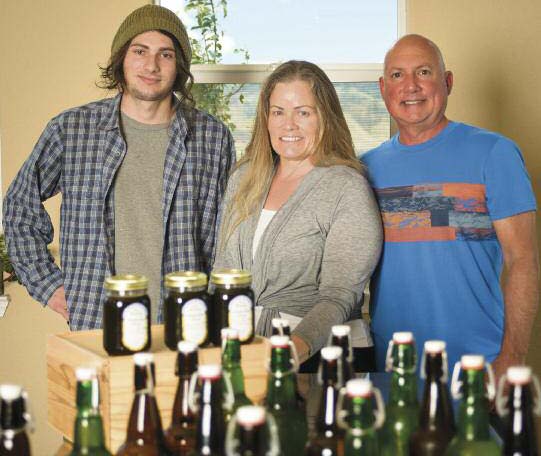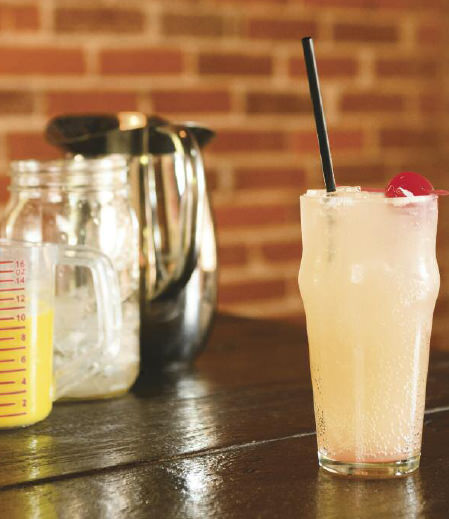drink tank
THE NEED FOR MEAD
Make your own honey wine this fall.
WRITTEN BY ERIN MEYERING
PHOTOS BY ASA GILMORE
Known to some as the nectar of the gods and said to have been enjoyed by King Tut himself, mead is one of the oldest known alcoholic beverages.
Mead, or honey wine, simply is aged, fermented honey and water. While store-bought meads often can have a syrupy, too-sweet taste, homemade mead’s flavor, alcohol level, and sugar content easily can be controlled (and perfected).
The quality of mead will depend on the quality of honey used.
“We try to use local as much as we can,” says Al Martinez, an avid Carson City home brewer. “The benefit is in quality, fresher ingredients.”
A toast to family
The Martinez family — Al, his wife Denise, and their son Ethan — has been making mead for about three years. But don’t let that short amount of time fool you; they have quickly become experts in the stuff, and they take it pretty seriously. Since converting their dining room into a brewing lair (complete with built-in taps and a temperature-controlled refrigerator), they’ve made many different recipes and now are experimenting with orange blossom mead and hallelujah honey mead made with honey from Carson City.

Flavor frenzy
“Mead is a great base for creativity,” says RJ Hiller, co-owner of BrewChatter in Sparks.
Hiller says you can add spices, flowers, hops, or fruit to mead, and the options for flavor become endless.
Rob Bates, owner of The Reno Homebrewer in Reno and mead-making veteran of 25 years, suggests experimenting with peppercorns, jalapeños, vanilla beans, cocoa nibs, and oak chips.
The Martinezes keep a log of their flavor ideas, and they’re talking about creating a hopped mead. They have perfected a blackberry, black currant, and blueberry sparkling mead.
So raise your glass with us, and one of these simple mead recipes below.
Erin Meyering is the associate editor of edible Reno-Tahoe magazine. In fall, she loves settling in with a new cookbook and sipping mulled apple cider. But now she may opt for a glass of homemade mead.
Resources
BrewChatter
1275 Kleppe Lane, Ste. 21, Sparks • 775-358-0477 • http://www.Brewchatter.com
The Reno Homebrewer
2335 Dickerson Road, Reno • 775-329-2537 • http://www.Renohomebrewer.com
Recipes
Hibiscus Semisweet Mead
(courtesy of R.J. Hiller, co-owner, BrewChatter in Sparks. Makes 1 gallon)
This mead will clock in at about 16 percent alcohol by volume. It’s perfect as an apéritif or paired with light entrées such as salmon or white fish.
4 pounds honey (preferably natural and unpasteurized)
1 1-gallon carboy with stopper (#6.5) and airlock (S-type)
1 package Fermaid K yeast nutrient
1 package diammonium phosphate yeast nutrient
1 2-ounce hibiscus flower (available at BrewChatter)
1 muslin bag, for steeping
1 package Lalvin 71B-1122 yeast
Star San no-rinse sanitizer
Mini auto-siphon and 3 feet tubing
1 6-quart stockpot
Thermometer
7 clear flip-top bottles or 10 clear 375-milliliter wine bottles with corks
Heat 1 gallon tap water on stove in stockpot to 150 degrees F. While water heats, add 1 ounce hibiscus flower (2 ounces for more pronounced floral character) to muslin bag and allow to steep in water as it comes up to temperature.
Once water has reached 150 degrees F, remove from heat and remove muslin bag from water. Begin mixing in honey. (It’s OK if water comes below 150 degrees F, but it should not get any hotter as honey begins to denature above 150 degrees, affecting flavor and aroma). Once honey is completely mixed in, add 1 gram Fermaid K (about a pinch, or ⅛ teaspoon) and 1 gram diammonium phosphate.
Cover stockpot and allow mixture to cool in refrigerator until it’s about 68 degrees F.
Sanitize 1-gallon carboy with Star San. Once cool, transfer mixture to carboy using auto-siphon. When it’s half full, add entire package of Lalvin yeast and finish filling. Leave neck plus about 2 inches for headspace. Sanitize and fill airlock and stopper, then put them in carboy. Leave fermenting must (mixture) in cool, dark place for 2 to 4 weeks.
During fermentation, on days 2, 7, 14, and 21, hydrate your Fermaid K by microwaving 1 to 2 ounces of water in it? to sterilize it and dissolving 1 gram of Fermaid K into it. Remove stopper from your fermenting must and slowly add mixture, replenishing yeast’s energy stores (continuing fermentation).
On bottling day, sanitize bottles and auto-siphon by submerging them in Star San solution for 2 minutes. Set up bottles below fermenter and begin transfer, filling all bottles one at a time and capping or corking them. This mead will be still, not carbonated.
Aging is the difficult part. The longer you allow new mead to sit, the better it will become. You can drink it right away; however, in 3 to 6 months, it will change character, bursting at the seams with honey and hibiscus flavors and aromas. Store at room temperature in cool, dark place.
Mini Mead
(courtesy of Rob Bates, owner, The Reno Homebrewer in Reno. Makes 1 gallon)
This is a smaller, scaled-down version of Bates’ Gold Medal Mead recipe, which won in the mead category at an American Homebrewers Association competition about 10 years ago.
3 pounds honey
½ ounce oak chips
1 teaspoon diammonium phosphate yeast nutrient
1 teaspoon Irish Moss fining agent
1 package Lalvin EC-1118 yeast
Sterilize everything with solution of iodophor or weak, unscented chlorine bleach (1 teaspoon bleach to 1 gallon water). Do not rinse.
Bring 1 gallon of water to boil. Add honey and Irish Moss and boil for 15 minutes. Turn off heat and add yeast nutrient.
Cool mixture to below 90 degrees F. Add yeast. Let mead ferment at 70 to 90 degrees F for 4 weeks.
Siphon mead into glass jug and add oak chips. Age mead in jug for 8 weeks, then bottle at age 6 to 12 months. (You may need to hide it from yourself so you aren’t tempted to drink it.)
Fermentation and condition at lower temperatures will make entire process take longer. Don’t rush it, though, as mead improves with age.


